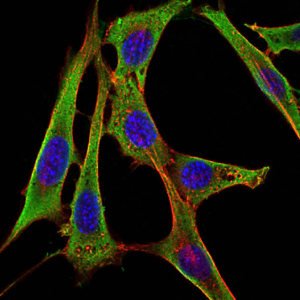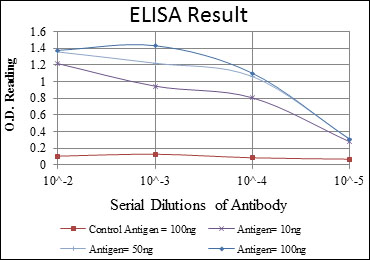Fibrinogen γ Monoclonal Antibody
- Catalog No.:YM0269
- Applications:WB;IF;ELISA
- Reactivity:Human
- Target:
- Fibrinogen γ
- Fields:
- >>Complement and coagulation cascades;>>Platelet activation;>>Neutrophil extracellular trap formation;>>Staphylococcus aureus infection;>>Coronavirus disease - COVID-19
- Gene Name:
- FGG
- Protein Name:
- Fibrinogen gamma chain
- Human Gene Id:
- 2266
- Human Swiss Prot No:
- P02679
- Mouse Swiss Prot No:
- Q8VCM7
- Immunogen:
- Purified recombinant fragment of human Fibrinogen γ expressed in E. Coli.
- Specificity:
- Fibrinogen γ Monoclonal Antibody detects endogenous levels of Fibrinogen γ protein.
- Formulation:
- Liquid in PBS containing 50% glycerol, 0.5% BSA and 0.02% sodium azide.
- Source:
- Monoclonal, Mouse
- Dilution:
- WB 1:500 - 1:2000. IF 1:200 - 1:1000. ELISA: 1:10000. Not yet tested in other applications.
- Purification:
- Affinity purification
- Storage Stability:
- -15°C to -25°C/1 year(Do not lower than -25°C)
- Other Name:
- FGG;Fibrinogen gamma chain
- Molecular Weight(Da):
- 52kD
- References:
- 1. Biochemistry. 2009 Sep 15;48(36):8656-63.
2. Blood. 2009 Nov 5;114(19):3994-4001.
- Background:
- The protein encoded by this gene is the gamma component of fibrinogen, a blood-borne glycoprotein comprised of three pairs of nonidentical polypeptide chains. Following vascular injury, fibrinogen is cleaved by thrombin to form fibrin which is the most abundant component of blood clots. In addition, various cleavage products of fibrinogen and fibrin regulate cell adhesion and spreading, display vasoconstrictor and chemotactic activities, and are mitogens for several cell types. Mutations in this gene lead to several disorders, including dysfibrinogenemia, hypofibrinogenemia and thrombophilia. Alternative splicing results in transcript variants encoding different isoforms. [provided by RefSeq, Aug 2015],
- Function:
- disease:Defects in FGG are a cause of congenital afibrinogenemia [MIM:202400]. It is a rare autosomal recessive disorder characterized by complete absence of detectable fibrinogen.,disease:Defects in FGG are a cause of thrombophilia.,domain:A long coiled coil structure formed by 3 polypeptide chains connects the central nodule to the C-terminal domains (distal nodules). The long C-terminal ends of the alpha chains fold back, contributing a fourth strand to the coiled coil structure.,function:Fibrinogen has a double function: yielding monomers that polymerize into fibrin and acting as a cofactor in platelet aggregation.,miscellaneous:The gamma-chain carries the main binding site for the platelet receptor.,online information:Fibrinogen entry,PTM:Conversion of fibrinogen to fibrin is triggered by thrombin, which cleaves fibrinopeptides A and B from alpha and beta chains, and thus exposes th
- Subcellular Location:
- Secreted .
- Expression:
- Detected in blood plasma (at protein level).
- June 19-2018
- WESTERN IMMUNOBLOTTING PROTOCOL
- June 19-2018
- IMMUNOHISTOCHEMISTRY-PARAFFIN PROTOCOL
- June 19-2018
- IMMUNOFLUORESCENCE PROTOCOL
- September 08-2020
- FLOW-CYTOMEYRT-PROTOCOL
- May 20-2022
- Cell-Based ELISA│解您多样本WB检测之困扰
- July 13-2018
- CELL-BASED-ELISA-PROTOCOL-FOR-ACETYL-PROTEIN
- July 13-2018
- CELL-BASED-ELISA-PROTOCOL-FOR-PHOSPHO-PROTEIN
- July 13-2018
- Antibody-FAQs
- Products Images

- Western Blot analysis using Fibrinogen γ Monoclonal Antibody against human Fibrinogen γ (AA: 210-437) recombinant protein.

- Immunofluorescence analysis of NIH/3T3 cells using Fibrinogen γ Monoclonal Antibody (green). Blue: DRAQ5 fluorescent DNA dye. Red: Actin filaments have been labeled with Alexa Fluor-555 phalloidin.




